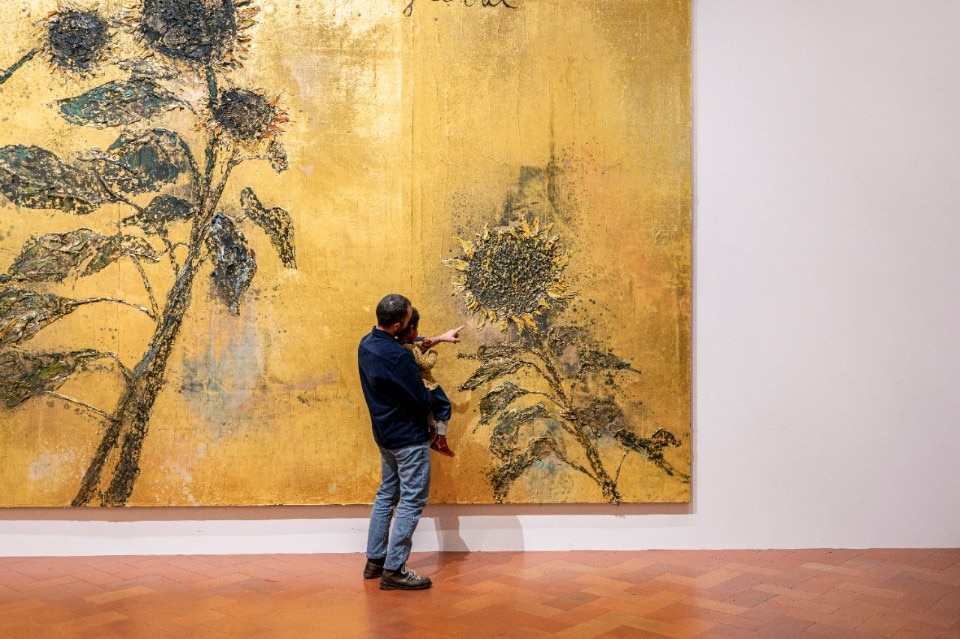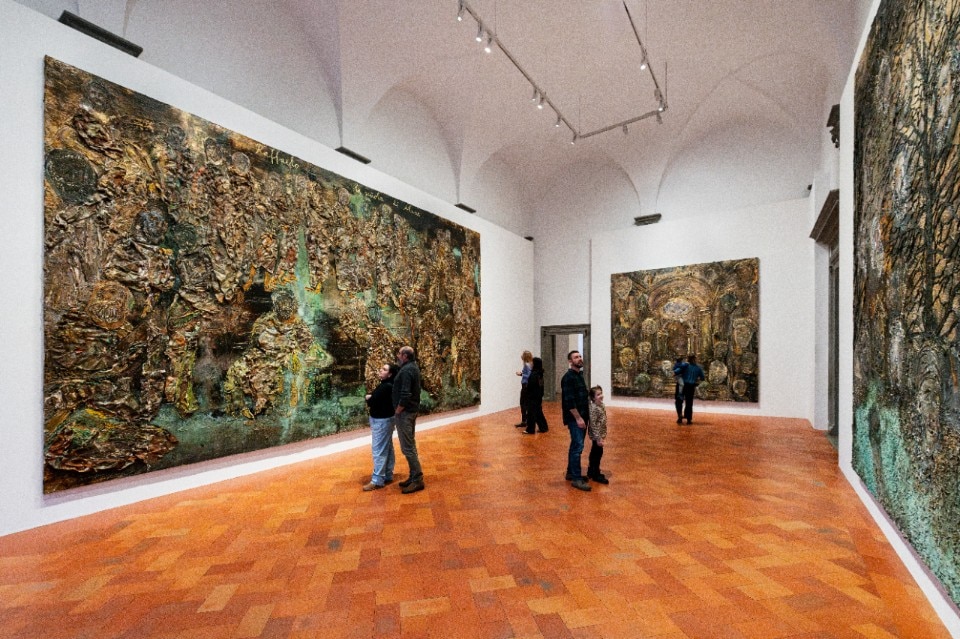“Philosophy is not a substance, but an intensity that can suddenly animate any realm: art, religion, economics, poetry, desire, love, even boredom. It resembles more like something like wind or clouds or a storm: like these, it suddenly produces, shakes, transforms and even destroys the place where it has produced itself, but just as unpredictably passes and disappears.” This definition of philosophy by Giorgio Agamben (Agamben, 2016), which conveys the feeling of jolting given by the exercise of thought, suggests the vital and reflective impulse brought about by Anselm Kiefer’s painting.
For the German artist, “painting is philosophy,” and around this fundamental assumption revolves the monumental exhibition that Fondazione Palazzo Strozzi is dedicating to one of the most important masters of contemporary art, curated by Arturo Galansino, director of the Florentine institution and open until July 12.

The title, Anselm Kiefer. Fallen Angels. evokes an episode shared by Christian and Jewish traditions, featured in the large work installed in the courtyard of Palazzo Strozzi, Engelssturz (2023), the fall of the rebellious angels, cast out of paradise by the archangel Michael, after rebelling against God. This work, the starting point of the exhibition path, highlights, on the one hand, the formal relationship with Italian and Renaissance culture, owing to the link with Simone del Pollaiolo’s courtyard, the 14th-century inspiration of the gilded background, and the reference to the painter Luca Giordano (1634-1705); on the other hand, it recalls the all-too-human oscillation in the struggle between good and evil.
This piece will remain in the courtyard until the end of the exhibition, weathered in a "never finished" process typical of Anselm Kiefer’s practice.
Philosophy is not a substance, but an intensity that can suddenly animate any realm: art, religion, economics, poetry, desire, love, even boredom.
Giorgio Agamben
“Destruction is a means of making art,” according to the artist, and the intense site-specific installation Vestrahlte Bilder (1983-2023) creates a sense of alienation in those who pass through it, in a reflection on the fragility and transformative power of matter and art: the walls of Palazzo Strozzi’s largest room are entirely covered with sixty canvases of various sizes, made by Kiefer over forty years, deteriorated and discolored by plutonium radiation. A mirror is placed in the center of the room, and the effect is one of infinite sinking.

The initial motif of the fallen angels is taken up again at the beginning of the exhibition, with Luzifer (2012-2023), in which the most famous of the rebel angels, Lucifer, is the main actor. With the ominous three-dimensionality of the lead airplane wing protruding from the surface of the canvas, the work again speaks of humanity’s contradictions, technological progress, and humanity’s use of it, and to do so it chooses to evoke the myth of Icarus, an example of mankind’s insolence.
As is typical of Kiefer’s art practice, the works in the exhibition derive from a layering of meanings and references, drawing on Christian and Jewish traditions, philosophy, poetry, myth, and ancient history, bringing out core subjects deeply rooted in the master’s art, in a journey of recent works and works from past decades that engage in dialogue with the Renaissance austerity of Palazzo Strozzi’s architecture.

A selection of works dedicated to mythology and the figures of classicism reaches its peak in the second room with a tribute to Heliogabalus, a young and controversial Roman emperor of the third century, to whom Kiefer dedicates two huge canvases with vibrant golden backgrounds featuring huge sunflowers, recalling van Gogh artworks, celebrating the cult of the sun and light triumphing over darkness. Also, the female figures of Danae (2016), Cynara (2023), and Daphne (2008-2011), all three featuring episodes from Ovid's Metamorphoses, a treasured text for the search for inspiration in the Renaissance.
As is typical of Kiefer’s art practice, the works in the exhibition derive from a layering of meanings and references, drawing on Christian and Jewish traditions, philosophy, poetry, myth, and ancient history.
To philosophy that literally becomes painting, Kiefer dedicates three large-scale works, The School of Athens (2022), Vor Sokrates (2022) and Ave Maria (2022), tracing the evolution of ancient thought, and anticipating Hortus Philosophorum (1997-2011), a cathartic work for overcoming human finitude.

Literary references are not lacking either: from Joyce’s Finnegans Wake, to Raymond Roussel’s Locus Solus, to the famous lines from Salvatore Quasimodo’s poem “Ed è subito sera,” which, written by Kiefer himself on a wall in the last room, close the exhibition, flanking four photographs printed on paper mounted on lead from the Occupations of the late 1960s, in the series Heroische Sinnbilder (2009).
Looking closely at the layering of thoughts and materials deposited on these battered canvases, thinking about their long and arduous process of composition, a perfect circle is created in which “Rubble represents not only an end, but also a beginning.” So, it is no wonder that in the documentary presented at Cannes Film Festival last May by German director Wim Wenders, Anselm (2023), we see Kiefer whistling in his immense studio as he rides lightly on a bicycle through the ruins of his art, thriving with new meanings.
Opening image: Anselm Kiefer, Engelssturz, 2023. Photo © Ela Bialkowska Okno Studio
- Exhibition:
- Anselm Kiefer. Fallen Angels.
- Location:
- Palazzo Strozzi, Florence
- Dates:
- from 22nd March to 24th July 2024

.jpg.foto.rbig.png)

.jpg.foto.rmedium.png)
.jpg.foto.rmedium.png)
.jpg.foto.rmedium.png)
.jpg.foto.rmedium.png)
.jpg.foto.rmedium.png)
.jpg.foto.rmedium.png)
.jpg.foto.rmedium.png)
.jpg.foto.rmedium.png)
.jpg.foto.rmedium.png)
.jpg.foto.rmedium.png)
.jpg.foto.rmedium.png)
.jpg.foto.rmedium.png)
.jpg.foto.rmedium.png)
.jpg.foto.rmedium.png)
.jpg.foto.rmedium.png)
.jpg.foto.rmedium.png)
.jpg.foto.rmedium.png)
.jpg.foto.rmedium.png)
.jpg.foto.rmedium.png)
.jpg.foto.rmedium.png)
.jpg.foto.rmedium.png)
.jpg.foto.rmedium.png)
.jpg.foto.rmedium.png)
.jpg.foto.rmedium.png)
.jpg.foto.rmedium.png)